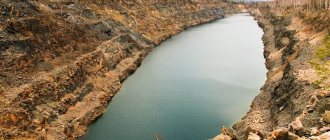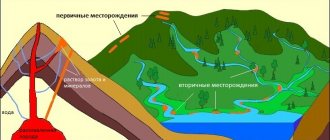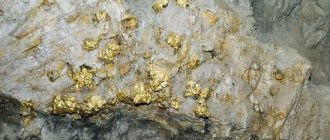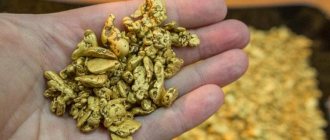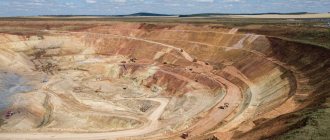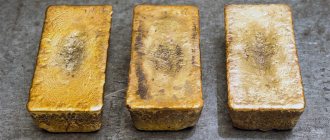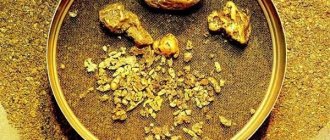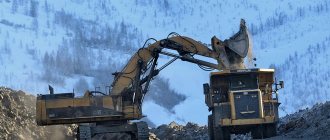Prehistory
It has been proven that the Chud tribes, and later the Bashkirs, inhabiting the Miass region, mined and processed iron and copper ores in small smelting furnaces.
It is assumed that they could also melt gold. The first gold in the Urals was found near Yekaterinburg. It was the Berezovsky mine. The St. Petersburg Berg College has long received rumors that there is gold in the area of the Tashkutarganka River, which flows into the Miass River. Several expeditions were sent there, but the precious metal was never found (or did they not want to find it?). The fact is that lands with gold reserves immediately went to the treasury, i.e. to the state. Of course, the owners did not want to give these lands to the state
In the summer of 1797, the first deposit of ore gold was found on the Tashkutarganka River (now Leninsk), a left tributary of the Bolshoi Iremel River, not far from the Miass plant. It was opened by the reconnaissance detachment of Evgraf Mechnikov.
Tashkutarganka (Tash-Targanka), river, left tributary of Iremel, Miass basin, territory of the city of Miass. The name is Bashkir, meaning “the place where they broke (mined) stone” (tash - “stone”, kutaryu - “to break”, -gan - word-forming particle, -ka - Russian suffix).
| 2000 | 2001 | 2002 | 2003 | 2004 | 2005 | 2006 | 2007 | 2008 | 2009 | 2010 | 2011 | 2012 | 2013 | 2014 | 2015 | 2016 | 2017 | 2018 |
| Total produced, t | 5.3 | 5.9 | 6.5 | 7.4 | 6.3 | 10* | 3.7 | 3.7 | 5/13.6* | 5.3 | 5.6/15.5* | 6.7/18.5* | 7.2/19.9* | 7.1 | ||||
| alluvial | > 300 | < 300 | ~ 250 | 200 | < 200 | 53 | 152 | 108 | 201 | 180 | ||||||||
| passing from complex | 3000 | 3300 | 3700 | 3300 | 3400 | 3961 | 6452 | 9154 | 9925 | 10077 | ||||||||
| actually gold | 2000 | 2300 | 2500 | 3900 | 2700 | 5979 | 6992 | 6253 | 7823 | 9104 | ||||||||
| dumps | 526 | 500 |
* - total gold production according to annual comprehensive reports of the government of the Chelyabinsk region (apparently, subsequent losses of gold during the extraction of gold from zinc and copper concentrates were not taken into account. eRUDA.ru
)
There are 5 actual gold ore deposits listed on the state balance sheet, of which Kochkarskoye and Svetlinskoye are being developed. In addition to them, there are 9 complex deposits where gold is found together with copper pyrite and magnetite ores. There are also 43 gold placers, of which six are being developed, 6 are being prepared for development, and 31 are in state reserves.
The deposits that determine the potential of placer gold in the region include 6 deposits: Bayramgulovskoye, Severo-Svetlinskoye, Polygon No. 8, Kazanskoye, Bessonovskoye and Kordonny Log. Gold mining in the Miass River valley has been going on since the 18th century (1797 is considered the year of the discovery of gold ore “on Miass”). Quite large nuggets of gold were found here. So, in 1842, a nugget called the “Great Triangle” was discovered, weighing about 36 kg, which was the largest found in the country. Gold was washed in the valleys of many rivers, ranging from the Upper Ufaley to Nagaibaksky regions, including in the vicinity of Chelyabinsk. The Kochkarskoye field has been developed since the second half of the 19th century.
Until 1993, the exploitation of gold and placer deposits in the region was carried out by the Yuzhuralzoloto association, which included the Kochkarsky mine with two gold extraction factories, the Miass mine and two prospecting artels (Borovaya and Stepnaya). Since 1993, these organizations have collapsed, and a large number of small subsoil users have emerged. But most of them were unable to hold on to the “difficult Chelyabinsk gold” for long. Currently, the actual mining of ore gold is carried out by Yuzhuralzoloto CJSC and its branches, alluvial gold mining is carried out by Miasszoloto OJSC, Ingul LLC and Gidravlika CJSC. Almost all ore gold deposits have been transferred to subsoil users; 40% of deposits are licensed for placer gold. The main deposits that determine the mineral resource potential of the region are the Kochkarskoye, Svetlinskoye and Bereznyakovskoye gold ore deposits. Placer deposits are represented by small placers with low quality gold.
The largest placer is Polygon No. 8, located in the floodplain of the Miass River. The situation in the river valley calls into question its industrial use. The raw material potential of alluvial deposits is determined by 5 deposits - Bayramgulovskoye, Severo-Svetlinskaya placer, Kazanskoye, Bessonovskoye and Kordonny Log. The main part of placer deposits are technogenic-residual and technogenic-dump small placers of modern and ancient hydraulic networks. Geological work in the 70s and 90s tripled the region's gold resource base. Since 1993, the volume of financing and the volume of geological exploration have sharply fallen, and the resource base for both ore and placer gold has been steadily depleting. A significant part of reserve deposits cannot be brought into production for economic and environmental reasons. Dredging gold mining in the region has been stopped, there are practically no prospects for placer gold, and the number of facilities and enterprises engaged in hydraulic mining is declining.
Therefore, the problem of strengthening the raw material base of gold mining enterprises in the region is quite relevant, the main ways to solve it are through planned geological exploration to identify new deposits with higher quality ores and deposits of non-traditional geological and industrial types, including those suitable for development using geotechnological methods. At the same time, positive trends in the development of the region’s mineral resource base for ore gold: heap leaching, a new technological method of ore processing, significantly increases the possibility of extracting gold from gold-bearing crusts, the reserves of which are large. Now “Golden Heaps” are successfully operating at the Bereznyakovskoye and Svetlinskoye deposits, construction is being planned at the Kurosan deposits and the use of stale tailings from gold recovery factories, the reconstruction of the gold recovery plant (gold recovery plant) has been carried out, which has made it possible to almost double the processing of ores of Yuzhurpalzoloto CJSC, enterprises for the processing of old copper pyrites are operating stably deposits and are involved in the development of new copper pyrite objects, which also made it possible to increase the volume of actual gold production and the mineral resource potential for gold.
Productive deposits in placers are represented by clayey and high-clayey sands with the inclusion of gravel and pebbles of the Miocene and Oligocene. The main part of the placers is represented by technogenic-residual, sometimes technogenic-dump small placers of modern and ancient hydraulic networks. Primary gold deposits arise in the bowels of the Earth in difficult geological conditions. Gold is concentrated in quartz or other veins that cut through the rocks. Placer deposits are formed as a result of the destruction and redeposition of bedrock gold. Placers occur among Meso-Cenozoic deposits of the weathering crust and river valleys. The largest nuggets are extracted from the placers. Gold resources: - Kochkarskoye - Svetlinskoye Gold placer resources: - Miass group - Gumbey group - Bredinskaya group Gold-arsenic resources: - Novo-Troitskoye (near the town of Plast) Placers - accumulation of small fragments of rocks or minerals, formed due to the destruction of bedrock or deposits.
Balance of gold reserves in the Chelyabinsk region (for 2004)
Gold deposits are divided into three groups according to their genetic type: primary, complex and alluvial. In total, in 2004, 57 deposits were taken into account in the Chelyabinsk region with total on-balance and off-balance gold reserves of more than 340 tons, of which: 14 deposits were mined, incl. 3 primary, 4 complex and 7 placer; 10 gold deposits were being prepared for development: 4 of them are complex deposits, which contain gold as an associated component, and 6 alluvial gold deposits for hydraulic mining. The state reserve contains reserves of 33 deposits.
Primary, actual gold ore deposits
In the primary group, 6 actual gold ore deposits with quartz-sulfide ores are taken into account, with on-balance and off-balance reserves of 112 tons of gold, of which: 3 deposits were mined - Kochkarskoye, Svetlinskoye and Tambovskoye; There are 3 deposits in the State Reserve - South Kurosan, West Kurosan and Novo-Troitskoye.
Kochkarskoye field
It has been mined underground since 1867. The license holder for the right to develop the Kochkarskoye deposit is currently CJSC Yuzhuralzoloto. Ore is mined at horizons of 470 - 612 m. More than 1 ton of gold is mined per year. The ores of the Kochkarsky deposit are processed at a factory with a complete enrichment cycle - FZTsO im. Artyom, part of JSC Yuzhuralzoloto. The current beneficiation scheme provides for direct cyanidation with the deposition of gold on zinc dust, obtaining concentrates with their subsequent smelting and sending to refineries. The extraction of gold from the ores of the Kochkar deposit is 90%.
Svetlinskoye field
It has been mined by opencast mining since 1993 by JSC Yuzhuralzoloto. Ore was mined on ledges of horizons 350-315 m in the contour of the quarry with a design depth of 160 m. Up to 1.5 tons of gold are mined. The provision of Yuzhuralzoloto CJSC with balance reserves of the Svetlinskoye deposit is 12 years - 16 years. All ore mined at the Svetlinskoye deposit is processed at a gold processing plant and a pilot heap leaching plant. At the gold recovery plant (gold recovery plant), ores with a content of up to 3 g/t are processed, gold recovery is 80%. The KV installation processes ores with a gold content of 0.87 g/t, gold recovery is 60%.
Tambovskoye field
In 2003, the Tambovskoye field was put on the balance sheet after reserves were approved. The development of the Tambov deposit is carried out by Bredinskaya Gold Mining Yuzhuralzoloto LLC, which won the auction for gold mining; the license is in the process of being issued.
West Kurosan Field
In 2004, JSC Yuzhuralzoloto won an auction for gold mining; the license is in the process of being issued.
Complex gold deposits
In the complex group, 9 copper pyrite and iron ore deposits are taken into account, in which gold is an associated component (copper pyrite and magnetite ores containing gold), on-balance and off-balance reserves of more than 200 tons of gold, of which: 4 complex copper pyrite deposits are being developed, 4 deposits are being prepared for development; The state reserve is the Yuzhnoye field; geological exploration work has not been carried out on it; no applications for licenses have been received.
Uzelginskoye field
It has been mined underground since 1994. The license holder is Uchalinsky GOK OJSC; the deposit takes into account on-balance and off-balance reserves in an amount of more than 120 tons of gold. In 2004, about 3 tons of gold were mined. The mine's supply of balance reserves with a design productivity of 2.2 million tons of ore per year is 33 years.
The following products are produced from the ores of the Uzelginskoye deposit at the Uchalinskaya processing plant:
Copper concentrate – recovery – 12 %
gold.
Zinc concentrate – extraction – 8 %.
Dump tailings – recovery – 80% gold.
In 2004, 8 thousand meters of exploratory mine workings were completed at the field during operational exploration, and about 3 thousand linear meters were drilled. m of exploration core wells, testing was carried out.
Molodezhnoe deposit
It has been mined by open-pit mining since 1982. The license holder is OJSC Uchalinsky GOK. As of January 1, 2005, the deposit accounts for on-balance and off-balance reserves of approximately 10 tons of gold. Development of the deposit within the quarry contour has been completed; mining work in 2004 was carried out on reserves subject to underground mining. During 2004, less than 200 kg of gold was mined from the deposit. The mine's supply of balance reserves with a productivity of 400 thousand tons per year will be 15 years. All mined ore is processed at the Uchalinsky concentrating plant according to the collective-selective flotation scheme, resulting in the following products: Copper concentrate - recovery - 14%. Dump tailings - recovery -86% gold. In 2004, 23 core wells with a volume of 472 m were drilled at the field, 64.5 m of exploratory mine workings were completed, and 133 furrow samples were taken.
Talganskoye field
Since 1996, Uchalinsky GOK CJSC has been preparing the Talganskoye deposit for exploitation. In 2004, ore mining began at the Talgan deposit, and up to 100 kg of gold was mined. As of January 1, 2005, up to 7 tons of gold are accounted for in the deposit. The mine's supply of balance reserves with a design productivity of 200 thousand tons of ore per year is 15 years. In 2004, the following products were obtained at the Uchalinskaya processing plant from the ores of the Talgan deposit: Copper concentrate extraction - 17%. Zinc concentrate – 7%. Dump tailings – recovery – 76%.
Alexandrinsky field
It is developed by open-pit mining by OJSC Alexandrinskaya Mining AGK, producing: copper concentrate, gold recovery into concentrate - 38%, zinc concentrate - 10%. The consumer of copper concentrate is Kyshtym Copper Electrolytic Plant CJSC and UGMK-Holding LLC, Kazakhmys Corporation JSC, zinc concentrate is Chelyabinsk Electrolytic Zinc Plant OJSC. The enterprise's provision with balance reserves at the mine's design productivity of 400 thousand tons of ore per year is 4 years. In 2004, JSC AGK carried out geological exploration work on its own under the following projects: “Prospecting and appraisal work in the Babarykinsky ore field”, “Prospecting and evaluation work in the Katabuk ore field”.
Kruglogorskoye magnetite ore deposit
Magnetite ores (actually magnetite) Fe content = 40%, gold 0.66 g/t, silver 1.06 g/t. Reserves - 59 million tons. Average. The deposit has not been developed, it belongs to the category of those being prepared for development, Kruglogorsky GOK LLC is preparing a project for the development of the deposit.
Placer gold deposits
For the group of alluvial deposits, as of January 1, 2005, the region includes 42 deposits with on-balance and off-balance reserves of 26 tons of gold. According to the degree of industrial development, alluvial deposits in the region are taken into account as follows: developed - 7 deposits; during 2004, 1.3 million cubic meters were produced from alluvial deposits. m of sand containing 170 kg of gold; 6 deposits being prepared for development. there are 29 deposits in the State Reserve. According to the mining method, placer gold deposits are distributed as follows: for dredge mining, 4 deposits are taken into account, including: one being developed (Miass Pond) and 3 in the State Reserve (Pokrovskaya placer, Polygon No. 8 and Voroninskaya placer); for hydraulic production - 38 deposits, including: 6 being developed, 6 being prepared for development and 26 deposits taken into account by the State Reserve.
Miass Pond deposit
The Miass Pond deposit has part of the reserves for dredge mining, and part for hydraulic mining (off-balance reserves). It has been developed hydraulically since 1977, and by dredging since 1988. License for the right to develop the Miass Pond deposit from OJSC Miasszoloto. a) Dredge mining The development of the Miass Pond deposit in the dredge mining area was carried out by dredge No. 5 with a scoop capacity of 250 liters, equipped with gold recovery equipment: sluices, jigs, a concentration table, etc. During 2004, 589 thousand cubic meters were washed by dredge. m of sand, 27 kg of gold was obtained. Dredge mining has been stopped. Part of the balance reserves is located in a security pillar in an industrial development zone. b) Hydraulic gold mining was not carried out at the deposit in 2004, off-balance reserves at the deposit did not change.
Chashkovskaya placer
It has been developed hydraulically since 1988 (Leninskaya Hydraulics - three hydraulic units). The owner of the license for the right to develop the Chashkovskaya placer is OJSC Miasszoloto. In 2004, no mining work was carried out at the placer, and on-balance and off-balance gold reserves remained unchanged. At the Chashkovskaya placer deposit, balance reserves for development are unprofitable.
Moss swamp deposit
The placer has been known since the middle of the 19th century. Until 1917, 250 kg of gold were mined at the deposit using the artisanal method. Geological study of the placer was carried out in the period 1930-40. The results showed the low efficiency of mining the deposit using the muscular method, which served as the basis for stopping the work. In 2004, Ingul LLC put the reserves of the residual man-made placer Moss Swamp on state registration. In the process of geological exploration, Ingul LLC carried out pilot development. Reserves were approved by TKZ, protocol No. 256 dated December 20, 2004, gold - more than 100 kg.
West-Iremel group of placers
Developed since 2000 (hydraulic unit No. 291). The owner of the license for the right to develop the deposit is OJSC Miasszoloto. In 2004, less than 10 kg of gold was mined.
North Svetlinskaya placer
Developed hydraulically since 1995. The owner of the license for the right to develop the field is CJSC Gidravlika. During 2004, about 100 kg of gold was mined. Provision of balance reserves with an annual productivity of the enterprise of 500 thousand cubic meters. m of sand will be 8 years. Leading and accompanying operational exploration of the field was carried out.
Kazan placer
Developed hydraulically since 1994. The license holder is Zolotoe Fleece LLC. In 2004, about 50 kg of gold was extracted from the deposit. The mining was carried out with two hydraulic installations.
Chekmarskoye field
Developed hydraulically since 1994. The owner of the license for the right to develop the Chekmar deposit is LLC.
The Bayramgulovskoye placer gold deposit is being prepared for development by OJSC Miasszoloto. During 2004, no geological exploration or production work was carried out at the field. CJSC Gidravlika is preparing the Mikhailovskaya placer for exploitation. Mining and geological exploration work was not carried out at the placer in 2004. A project of constant conditions for the production of reserve calculations is under development. LLC has been preparing the Klopotlivaya, Kordonny Log and Krutoy Log placers for exploitation since 2001. In 2002-2003, work was carried out to prepare a feasibility study of conditions for the revaluation and recalculation of reserves for these placers. In 2004, the enterprise's activities at placers were discontinued. The Chernoborskoye field is being prepared for exploitation by LLC. In 2003, the deposit's reserves were approved by TKZ. In 2004, activities ceased. Placers Zoinsko-Ilyinskaya, Svobodnenskaya, Aleksandrovskaya, Bessonovskaya, Kamenno-Sanarskaya, Fambulovskaya are included in the list of licensing objects.
| According to the portal eRUDA.ru, in 2021, 7.2 g of gold was produced in the Chelyabinsk region - 8th place among the gold mining regions of the Russian Federation / The Yuzhuralzoloto company produced 15 tons of gold from all assets in the Russian Federation in 2021, 4th place in the ranking of leading gold mining companies in the Russian Federation |
| When using the information, hyperlink to www.eRUDA.ru - “Rating of gold mining companies Rating of gold mining companies”/eRUDA.ru/ |
| source |
First gold
The first vein gold in Miaas was discovered by Evgraf Mechnikov on July 9, 1797. The first experimental washing on the Miass River was carried out by the manager of the Miass plant, Porozov, in 1823. This is the starting point of industrial gold mining in the Southern Urals. In former times, and this is confirmed by documents, sometimes it happened to reach such a placer that a father and son, together, could mine thirty kilograms (!) of gold in a day...
On July 9, 1797, at the proposal of the main office of the State Department, the “Case of establishing the Miya Gold Mines” was launched. This date went down in history as official - “a party of gold prospectors under the leadership of Oberberghauptmann 3rd class Mechnikov” “discovered vein gold” for the first time in the Southern Urals. At the dachas of the Miass plant, scouts found several more gold-bearing veins, where mines were created. In 1798, a gold washing factory was installed on the dam of the Miass Pond.
Pervo.info
Gold in the Middle Urals was first discovered by the schismatic Erofey Markov in 1724. He reported his discovery to the mining board, but at that time they did not yet know how to search for gold in the Urals - no gold was found at the indicated place. Markov was suspected of deception. For Markov, the matter could have ended badly, but after trying several methods, the authorities finally found gold. This was the impetus for the organization of the Berezovsky mines, and then the Berezovsky gold mining plant, which included the Pilnaya mine in Pervouralsk.
______________________________
There are a lot of questions regarding everything related to gold mining in the Middle Urals. There are even discrepancies about the start date. So in the book of Vesnovsky V.A. “Essays on the Ural Gold Mining”, published in 1898, reports that Erofey Markov found gold in May 1724. Many modern publications indicate the date 1745.
According to the same Vesnovsky, vein gold began to be mined in the Urals in 1754, and alluvial gold only since 1774, and then sporadically. Serious mining of alluvial gold began after the foreman of the Berezovsky plant, Brusnitsyn, while looking for a nugget, came across sands that yielded 1.23 kg of alluvial gold in 40 days of work.
In 1822, the development of gold placers began at the Bilimbaevsky plant, and in 1823 at the Shaitansky plant.
As V.A. Volkov writes, the owners of the Shaitan factories, Matvey Filatovich Yartsev and his sons, actively took up the development of a new business. 9 mines were organized. The first and largest of them - Mariinsky - was located in the valley of the Izvyaznaya (Izvestnaya) River. Another mine - Bogaty - was located on the slope of Mount Mokra and left its name to descendants thanks to the ravine that descends to the Elnichnaya River on the right side, 400-500 meters below the Pilnensky Pond dam. Simonov Lozhok flows into the pond on the right side, which originates on the mountainside, where on the other side is the source of the Vyderka River. There was another mine here: Simonovsky or Vyderka.
According to him, from 1823 to 1885, 257 poods, 23 pounds, 16 spools and 24 shares of precious metal (4219.277 kg) were mined at the Shaitan mines.
Large gold mining did not bring wealth to ordinary workers. On the contrary, wild poverty and drunkenness reigned in the mines.
As Vesnovsky writes, the huge profits of gold miners did not stimulate them to mechanize mining and create normal working conditions.
He wrote about “old-fashioned methods of extraction:
“With such huge profits, the Ural gold miners, of course, can ignore any innovations.”
Meanwhile, about 50 thousand people were employed in the Ural gold industry in the Urals.
As Vesnovsky wrote, in the mines there are monstrous working conditions, lack of medical care, dirt, cold, child and female labor and drunkenness. Both among men and among women.
“Everyone drank, from young to old!” - Vesnovsky was indignant.
And here is how the writer D.N. described such drunkenness. Mamin-Sibiryak in the novel “Gold”:
“What can I say: put out a straight quarter!..,” Mylnikov, who was getting into a frenzy, boasted. – Does gold live without vodka? Let’s break out a quarter, and the gold is ready for you. Ordinary workers, who did not possess the gift of “literature” like Mylnikov, were content for the time being with taking the deposits from the city hunters and signing up for several exploration parties at a time, and, of course, drinking the money right there in the tavern. No one thought about getting new clothes or boots. All hopes were placed on the future, and in particular on the Kedrovskaya dacha.
In the novel “Wild Happiness,” not only the workers, but also the sons of the gold miner become drunkards at the mine.
As V.A. writes Volkov, at the turn of the 19th-20th centuries. On the initiative of the plant owners Vasily Pavlovich and Sergei Pavlovich Berg, the extraction of chemical gold (amalgamation) began by re-processing already washed sands and ores with chemicals. It is known that in 1914, more than a pound of precious metal was obtained in this way.
By the end of the 19th century, the production of Ural gold began to fall - Eastern Siberia took first place in gold mining.
- Gold mining in the empire in 1893:
- Eastern Siberia - more than 29 tons.
- Ural - more than 12 tons.
- Western Siberia - about 3 tons.
According to Vesnovsky, the gold deposits were rich, but only “light” gold was mined, which did not require mechanization of labor.
Only 30 percent of gold in the Urals was mined by mechanical washing. The rest is done manually.
After this time, the share of placer gold production begins to fall (up to 25 percent), and ore gold production begins to grow (up to 75 percent).
By the time of the revolution and civil war, according to Soviet researchers, 750 tons of gold were mined in the Urals.
It is difficult to say how many of them were mined in the vicinity of Bilimbay and Shaitanka.
Pervouralsk local historian of the 19th century Alexander Toporkov wrote:
“In addition, some residents are engaged in artisanal work in gold mines, in artels of 5–10 people, receiving from the factory office from 2 rubles 25 kopecks per spool (4.266 grams) of gold washed from the sands. up to 2 rub. 40 kopecks The payment, due to working conditions, is not particularly large, and therefore the secret sale of washed gold into the wrong hands is very common among miners, which results in 5 to 5 rubles. 50 kopecks for the spool. Some go in the spring to the mines of other owners, who, when hired for work, give money in advance, and the prices are almost twice as high, with food from the employers.”
After the October Revolution, gold mining in the Pervouralsk region increased significantly. A whole village of prospectors was formed. But Tolkuchka will tell you about this next time.
Newspaper "Tolkuchka" dated 10/18/2019
Anatoly Gusev
Photo by UraloVed
In the photo: the scenery for the film “Gold” based on the works of D.N. Mamin-Sibiryak in the village of Kamenka, Pervouralsk GO
Gold Saw
This is how the “gold rush” began.
The fame of Tashkutarganka quickly spread throughout Russia, and the second life of the Miass gold mining region began. There are known cases when, in the bed of this fabulously rich river, up to ten kilograms of gold were extracted from a ton of sand, most of it being large nuggets. It was unprecedented wealth.
If ore gold, which required large expenses, was mined somehow and even some mines were abandoned due to the poverty of the metal content, then the relative ease of mining placer gold opened up broad prospects for entrepreneurship.
It was no coincidence that the Mining Department showed increased interest in the extraction of Miass gold. As a result of the increasing decomposition of serfdom, the country experienced increasing financial difficulties. The national debt grew continuously. Therefore, forced gold mining was one of the ways to plug holes in the budget of Tsarist Russia.
In the 30s of the 19th century, the gold rush reached its highest limit. The news from the golden Ural storeroom stunned the imagination. In one day, a gold treasure of six nuggets was found on Tashkutargaik with a total weight of 24 pounds 11 spools - more than eight kilograms!
The entire Miass valley turned into a huge gold mine. In 1836, 54 mines and 23 gold deposits were being developed here. According to some reports, the total number of gold mines in these years reached 162.
The Miass plant became a major center of the Russian gold industry, surpassing the ancient Berezovsky mines in the Urals in terms of production of valuable metal. In the “golden age” of mining - 1827 - 64 pounds of gold were mined here. From 1830 to 1837, production fluctuated from 52 to 61 pounds per year. During these eight years alone, the Miass Valley gave the treasury eight tons of gold. Subsequently, until 1861, production continued at almost the same level.
Economy
On the territory of the Miass District, 385 deposits and occurrences of minerals (196 primary, 189 placers) have been identified, localized mainly in the valley of the Miass River, including ore (indigenous) gold (66 deposits and occurrences), placer gold, talc, semi-precious stones, chromium , building stone, copper, muscovite, nickel, iron, lead, molybdenum, niobium, titanium, aluminum, asbestos, graphite, fluxing limestone, ceramic raw materials, facing materials, clay, sand and gravel, peat, phosphorites, groundwater.
The Solnechnaya Dolina ski resort is located on the territory of Miass.
“Mad money” and economic growth
With the beginning of gold mining in the city, a large amount of cash and people with large incomes appeared, demands grew. The construction of shops, salons, and roads began in the city. The Peter and Paul Church has ceased to accommodate all the parishioners, the number of which is due to the arrival of those wishing to “try their luck.”
Miass began to turn into a large industrial, commercial, administrative and church center. In the remote corners of the forest, robbers became more active. It was much safer and more profitable to rob defenseless gold miners than well-guarded factory convoys (dark kingdom?).
Most of the most famous historical buildings in Miass were built during the “first wave” of the gold rush.
Gold and people
The fates of people who were suddenly hit with huge amounts of money turned out differently. The most famous example is that of the artisan Simonov, who lived in poverty and became the richest resident of the city, who managed to competently manage the income he received, going from a simple prospector to the owner of the mines.
Of course, not everyone spent their money so wisely. According to the memoirs of contemporaries, some prospectors, having suddenly become rich and crazy with happiness, went on a spree. We walked widely, with gypsies, riding in troikas, rented restaurants alone, and in the morning, waking up without a penny of money, collecting a knapsack and the last piece of bread, we again went into the taiga to look for “luck.”
Gold did not bring happiness to everyone; the most illustrative case is that of Nikifor Syutkin, a state-owned craftsman at the Miass plant.
Syutkinsky nugget
On October 26, 1842, in a trench that had already been mined and, it seemed, had run out of gold by that time. He discovered a nugget at the Tsarevo-Alexandrovsky mine, the largest in the history of gold mining in Russia. And this was at a time when the issue of closing the mine was being decided: the placer, which once yielded 52 nuggets weighing from one to seven pounds in one year, seemed to have hidden its untold riches somewhere! The gold washing factory has already been dismantled. And so Nikifor Syutkii, working in a pit at a depth of three meters, mined a whole block of gold - a nugget weighing 2 pounds 7 pounds 92 spools (36 kilograms 21 grams). The mine caretaker, Staff Captain Schumann, took the Syutka nugget under guard to the Zlatoust plant to the mining chief, Major General Anosov, and from there to Yekaterinburg and St. Petersburg. They talked and wrote a lot in Russia and abroad about this amazing Ural find, valued at 28,146 gold rubles. What happened to the discoverer? The nugget of freedom and happiness did not bring him. So Syutkin remained a government worker, a serf. Subsequently they wrote that he drank bitter, and he, swollen, ragged and shackled at the hands and feet, was brought by order of the plant administration to the mine and, in the presence of the mine workers who had come running to the beats of the drum, was subjected to cruel torture with rods. Nowadays the Syutknian gold giant is kept at the exhibition of the Diamond Fund in Moscow, like some other Miass nuggets. Geologists all over the world know about the “Great Triangle,” as the unique nugget was called for its unique external shape; many scientific treatises have been written about it, and it is mentioned in geological and mineralogical textbooks.
“Golden Cast Iron” by Pavel Anosov
The creator of the famous Zlatoust damask steel, P.P., left a big mark on the history of the development of Miass gold mining. Anosov. During his tenure from 1833 to 1847, the head of the Zlatoust mining district, the Mnassky plant took a leading position in gold mining in the Urals and in Russia. Over these years, the mines produced 790 pounds of gold.
He proposed a new method for processing gold-bearing sands by “smelting them into cast iron and extracting gold from apago by chemical means,” which will make it possible to “extract 20 times more gold from sands without washing.” To prove the enormous benefits of his method of smelting “golden cast iron,” Anosov himself conducted smelting in a factory furnace at the Miass plant. But tsarist officials did not support the innovator and thwarted the introduction of this method into mining practice.
Goldmine
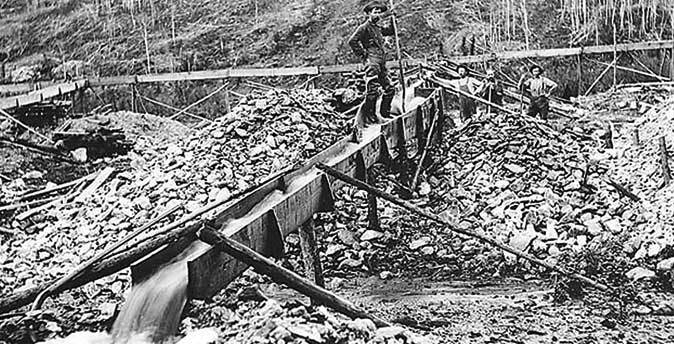
The story of how one find gave rise to a chain of events that made the Urals a gold mining center for many years
Industrial gold mining in Russia began exactly 270 years ago: with three or four shiny stones dug up near Yekaterinburg on May 21 (June 1), 1745, between the Shartashskaya and Stanovaya villages by the Old Believer Erofey Markov. Gold was not his goal - he was looking for “tumpas” and “stroganets” (smoky and transparent rock crystal) for a cutting factory. But over time, through the efforts of the Ural miners, the semi-handicraft gold mining industry turned into a powerful industry.
Berezovsky unique
Mentions that there are large deposits of precious metals on the territory of modern Russia were found back in the 5th century. But only ten centuries later, under Tsar Ivan III, their search became a state task: many favors were promised to those who found gold and reported it to the authorities, and terrible punishments to those who found and hid it. The efforts, however, were in vain: no one provided official data about the gold found. Later, Peter I developed active efforts to discover domestic gold, but equally unsuccessfully.
Only 20 years after the death of the first Russian emperor, the accidental discovery of Erofei Markov radically changed the situation. Where, among the swamps, he first dug up “a pebble with particles like gold,” a mine was founded in 1747, which gave rise to the rich Primary mine. Geologists note that this is an amazing, unprecedented fact in the world history of searching for and finding gold, since in all gold-mining countries alluvial deposits were first discovered, and only then primary (vein) deposits. In Russia it’s the other way around.
The mine became the founder of the Russian gold mining industry as an independent industry. Ten years later, by order of the mining chief Nikifor Kleopin, the first specialized gold washing plant in the Russian Empire was built and launched here.
Later it turned out that this was a unique world-class vein gold deposit, included in geological textbooks in all countries of the world. It turned out to be incredibly rich and long-lived: in more than 250 years (work was interrupted only during the period of devastation from 1923 to 1929), over a thousand mines were built here. Four are still in operation, with one of the mines recognized as the oldest operating mine in the world.
The Old Believer’s luck inspired many to search for gold: in the 18th century, primary gold deposits were found in the Urals at the Shilovo-Iset copper mine, in the area of the Nevyansk plant, Nizhny Tagil, and Miass.
Brusnitsyn fever
But the real gold rush was sparked by the discovery of placer gold made by foreman Lev Brusnitsyn near the same Berezovsky mine in September 1814. And if the previous find was simple luck, then this one was the result of many years of work and incredible ingenuity. Lev Brusnitsyn is not an accidental person in the mining industry: from the age of 11 he worked as a panner in gold mines, and by the age of 30 he became the technical director of a large gold washing factory at that time. He was sent to develop new industries throughout the Urals and Siberia.
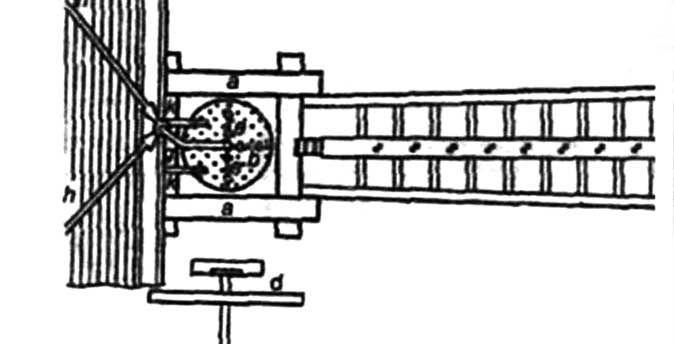
“American” (or “prohodnushki”) on a stream in the Klondike River basin (1886 - 1900). The device, which operates on the Brusnitsyn principle, became widespread in California and Alaska during the American “gold rushes.”
A good knowledge of the peculiarities of the occurrence of indigenous gold helped him discover placer gold. He searched purposefully. While examining the old folding dumps of the Petropavlovsk ore crushing factory, I noticed two grains of gold, different in color and shape from those mined from bedrock ores. A long search for the place where they got into the tray led to rich gold-bearing sands in the basin of the Pyshma and Berezovka rivers.
The merit of Lev Brusnitsyn is not only that he was able to discover the first placer gold in Russia. He was the first to use a new method of extracting precious metal - washing, he himself designed washing machines, and managed to organize industrial mining. Moreover, all his inventions were economical and easy to use.
The discovery of a new type of gold deposits - easily enriched, accessible to even one person for mining in the most primitive ways - marked the beginning of the world's first gold rush. It was from here that this “epidemic” spread throughout the planet. Numerous placers of the precious metal were found in other areas of the Urals, in Siberia and Altai, which served as a new powerful impetus for the development of the gold industry in the country, which so needed money after the ruinous war with Napoleon. From 1812 to 1845, the volume of gold production in Russia increased 20 times, which brought it to first place in the world. The country provided half of the world's production of the precious metal.
Gold of the North
The discoveries and inventions of Lev Brusnitsyn determined the approach to gold mining in the Urals for centuries to come - mainly alluvial deposits were mined here. Moreover, there were a lot of them.
A new stage of gold mining in the region is associated with the discovery in 1985 in the north of the Sverdlovsk region near Krasnoturinsk of a new large gold deposit - Vorontsovsky (gold reserves - 65 tons, silver - 58 tons). Geologists knew that sooner or later they would find it, because the placer deposits with which the region was saturated were derived from the indigenous ones. Deposits were discovered by starting additional exploration of the Severopeschanskaya iron ore mine.
To develop Vorontsovka, in 1993, a group of local entrepreneurs, with the participation of the Krasnoturinsk administration, created the “Gold of the Northern Urals” enterprise. The shareholders tried to find ways to develop this deposit, but they lacked enterprise and courage - the deposit resembled a layered pie: oxidized ores on top, and primary gold-sulfide ores below. It was necessary to create a mining and metallurgical production facility, including one using leaching technology (dissolving precious metals using cyanide). At that time, there was no experience of effective industrial application of this technology in the domestic industry. In the USSR, similar ones were developed only in the uranium deposits of Central Asia, where miners and metallurgists were engaged in underground leaching of uranium ores: the chemical and physical principles of gold and uranium mining are similar.
Tsarevo-Alexandrovsky mine (Leninsk)
In 1824, Tsar Alexander I visited the Miass gold mines.
Not long before this, the richest mine on Tashkutarganka was called Tsarevo-Alexandrovsky, which, of course, was brought to the attention of His Imperial Majesty. Alexander I arrived, as he put it, “to his mine” on September 23. Here he wanted to “try” his luck
It was a clear September day in 1824. According to rumors, while they were waiting for the tsar, just before his arrival, Dementy Petrov, a simple man, dug out a nugget worth eight pounds from the “tsar’s” face, the same one that was later called the foundling. The find, on the one hand, gave hope that the emperor would also be lucky, but, on the other hand, Dementia’s nugget could have gone to the king if he had not gotten ahead of him. However, the nugget still ended up with Alexander - it was handed to him along with bread and salt when the king arrived on the shore of Tashkutarganka.
A king with a shovel in his hand at the bottom of a rather deep hole is not an ordinary picture. Yes, Alexander took a shovel - “I’m like a Bergauer” - and began to dig into the clay. The others also grabbed shovels and began to pick at random, glancing sideways at the monarch. Having loaded several boxes, which were immediately raised up, Alexander put down the shovel, took hold of the pick, stuck it into the sand and hit some stone. They helped him turn it out, and Alexander rose to the surface with a stone in his hands. He was greeted with applause. “Am I really that happy?” - he was surprised, hoping that he had a nugget in his hands.
Then, in front of the king’s eyes, 22 pounds of ore mined by him were washed. They contained 12 spools, which the sovereign prospector took as a souvenir, along with Petrov’s nugget and a piece of ore he dug up. Having distributed gifts to everyone - money to Petrov and other workers, an order to the head of the Zlatoust mining plants Tatarinov, Alexander left “his” mine. I shouldn't have rushed. Because on the same day, in the same face, a nugget weighing more than eleven kilograms was recovered. And for another two weeks we came across nuggets - some worth three, some worth five, some worth all of 10 kilograms. There were a dozen of them in total.
Riot at the mine
This was shortly after Tsar Alexander I arrived at the Miass gold mines at the Tsarevo-Alexandrovsky mine.
At the mine in those days, the cruel man Shlykin was the caretaker.
The workers feared him like fire, but they were also angry with him, therefore this Shlykin killed a lot of people, and through his fault many people perished under the executioner’s lashes and in eternal hard labor.
Then workers were driven from everywhere to the gold mines and they were called exiles, and there were also many runaway convict soldiers, these were shackled in chains. There were burnt brands on the shackled men's foreheads, their ears were torn and their nostrils were also torn.
In the summer, the workers lived near the mines, in the open air, and in the winter in sheds-barracks on Kaskin, two miles from the mine - there was a mine office and the owner's industrial warehouses. They will lock the workers in the barracks, put a bucket, and a sentry at the door, outside. Like in prison.
The food was: cabbage soup, a pound of bread and boiling water. The workers lived poorly. They didn’t wash in the bathhouse for months at a time, but worked all day long from morning to evening. At that time they didn’t go into the mines; the treasury had enough gold at the top of the earth. The tools were: a pick, a shovel, a jello-mix and a wooden pump.
We had to work knee-deep in water, in low places. Here people died like flies, because, barefoot, in flimsy clothes, they caught colds, got sick and died, there was no help. There were no doctors or medicine in sight.
This time a field supervisor was on his way, and the workers were just having lunch right there near the washes. They sit around large wooden buckets and slurp bread. And just the counter-Tatar broke a piece of bread, and there was a baked mouse in it. The Tatar, of course, is also a man and does not eat mice. The hubbub rose.
At that time there were Vyatka men who worked at the mine under a contract. It was painfully difficult after the village to work in the fields. Shlykiya drove up to the workers and shouted: “What’s that noise?” Be silent! - How often is this? Feed the mice! We, tea, are not cattle! They were hiring - they said something, but now they say something else! We are not convicts, we will not torture mice.
And everyone surrounded the caretaker, and the Tatar thrust him a piece of bread with a mouse tail sticking out of it. The caretaker doesn’t want to know anything, he shouts his own: “What are you yelling about!” Throw away the mouse and eat! And the Tatar said: “I don’t want to go crazy!” Ashai yourself! He threw the bread at the feet of the caretaker’s horse: “Here’s your bread!” Mine is not a convict. Neat! I won't be shy.
The Vyatka Tatars supported him. “Record everyone!” the caretaker ordered the foreman. “And in the evening, if they don’t work, report to me!” He spurred his horse and rode off.
This party of workers started work, because it was a small group, and then there were armed soldiers and Cossacks with whips. The Cossacks whipped one or two with their whips, the soldiers hit them in the back with their rifle butts—you’ll have to work against your will.
Shlykin drove on, furious, not himself. And then he happened to see a red spot in one group of workers washing. I came closer, and this was a red shirt on a young guy. In those days, God forbid, if the bosses saw someone wearing a factory-made garment, it meant that the gold had been stolen by a worker, no less. Therefore, the earnings were barely enough for the worker to eat, and even if there were pennies left, you couldn’t get a red shirt for them. The guy's caretaker ordered him to be flogged. “He will know how to make red shirts with stolen gold.” The old father stood up for his son: “Have mercy,” he says, “your honor!” My shirt is already faded, my guy doesn’t drink, so he saved up for a shirt. Young, eager to go for a walk. It would be better not to say. My son and I were beaten at the same time.
And the next morning, five hundred Vyatka men and several shackles refused to work. Vyatsky’s: “Give us your passports!” Let's go home! And the shackles said: “I’m going to die anyway!” Let's not work! Bring on the manager! - A! Won't you? Okay! - and the caretaker ordered the Cossacks and officers to take the rebels named Bushmakov, Kondratyev, Yagomat Valiev and Kurochkin.
But the workers did not give it. They moved towards the guard and the officers and the caretaker, like an avalanche. They barely managed to reach the chapel—a monument in honor of Alexander’s arrival—and locked themselves up. But Shlykin realized what was going on earlier and sent a messenger to Miass with a report.
Only in the evening a hundred Cossacks rode up from Miass, and Bushmakov, Kondratyev, Yagomat and Kurochkin were taken and locked up. The workers refused to work - and they were also crowded, and the winter barracks on Kaskin were locked up and sentries were posted.
The workers held out for three days and did not go to work. On the fourth day, the governor and the mountain manager arrive from Zlatoust to the mine. First of all, of course, we talked to the caretaker Shlykin, the high authorities. And their conversation was like this: “To prevent others from doing so, flog the leaders!” Without any investigation, the governor wrote an order in the office: “For inciting a riot, run the leaders through the gauntlet...”
They took the workers out of the barracks and the governor came out with the manager. -What are you complaining about? Why are you lying idle? - We were deceived, your Excellency! Starved! We want to go home! “Give me the food you feed the workers!” the governor commanded. And there was meat cabbage soup, porridge and bread: the caretaker ordered it to be cooked perfectly this time. The governor tried the cabbage soup and barked: “Whip the instigators!” The workers moved forward, shouting: “This is a deception!” We will reach the king! The governor and the manager jumped into the carriage and off to Miass.
The next day, in a clearing near Kaskin, they lined up all the workers and led them in a circle through the line of leaders along the “green street.” Bushmakov, a Vyatka, hot-tempered man, was the first to pass through and received a hundred blows of the rod to the beat of drums. Kondratyev was a boy of about eighteen years old, he fell, they poured water on him and beat him again. Kurochkin Akim was a sick shackle, he fled from the Zlatoust plant. His throat was bleeding. He was beaten to death. Yagomat, a healthy Bashkir, when he walked down the “street”, shouted: “I still won’t work!” His Bashkirian comrades answered him from the ranks: “We won’t!” Be patient, Yagomat! Well, they beat Yagomat very hard - almost to death. And the body of Akim Kurochkin was buried by the Cossacks in the bushes near Kaskin. The workers had to get to work.
Soon Bushmakov, Yagomat and Kondratyev fled with the daughter of Akim Kurochkin from the mine. They were overtaken by the Cossacks in the Ilmen Mountains, beyond Miass. Bushmakov, Yagomat were shot, and Kondratyev and Aksyutka fled to an unknown destination.
Secret tales of the workers of the Urals, 1941
Sverdlovsk region: For gold
HomeTourists Weekend in Russia
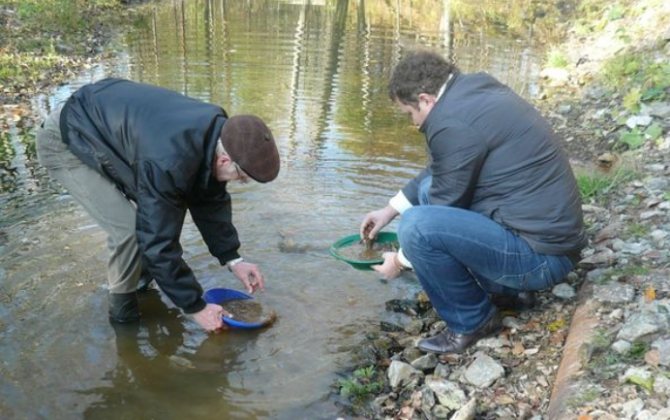
Berezovsky's gold
In our youth, we all read Jack London's stories about the Klondike Gold Rush. But few people know that in Russia the “gold rush” began 150 years earlier, in the Urals, in the settlement of Berezovsky, which owes its appearance to gold. We didn't know this either. Therefore, from the many excursions offered to us by Yekaterinburg operators, we chose “Berezovsky - the birthplace of Russian gold.” By the way, until recently the “Berezovka residents” themselves had more than a vague idea of the “golden” past of their city. Local businessman Valery Lobanov took up the task of restoring historical justice. He has created several attractions and excursion programs on the "gold" theme and is planning new ones, organized a tour that is the only one in Berezovsky that accepts tourists, supports scientific research concerning the history of gold mining, and does much more to restore Berezovsky's name as the "homeland of Russian gold." Ekaterinburg travel agencies cooperate with Aurum. She organized an excursion to Berezovsky for us.
Gold was found in Berezovsky by accident. In May 1745, peasant Erofey Markov from the village of Shartash (now Shartash is one of the districts of Yekaterinburg), while searching for rock crystal, found “grains” similar to gold. This event is described in the tale “Golden Dykes” by Pavel Bazhov. Erofei Markov reported the find to the head of the mining plants in Yekaterinburg, and he ordered the find to be investigated. The “grains” really turned out to be golden. It was a real sensation! After all, legends about the countless gold treasures of the Urals have haunted gold miners for centuries. But the searches were absolutely unsuccessful. So much so that in 1682, Tsar Fyodor Alekseevich admitted that there was no gold in the Moscow state. For two whole years, geological surveys were carried out at the site where Erofey Markov was found, but no gold was found. And only two years later the first dike (vein) was found and the Shartashsky mine was built. Later, the entire deposit began to be called Berezovsky after the name of the gold-bearing Berezovka River. This is a fabulously rich and long-lived deposit. Over 250 years, more than a thousand mines were dug here. At other times, more than a hundred mines operated simultaneously. In 1973, an obelisk was erected in the place where Erofey Markov found the first Ural gold. And later, in the historical park of Berezovsky, a monument to Erofey Markov himself was erected.

From Yekaterinburg to Berezovsky - 12 km, just half an hour from the center. Berezovsky was once the “golden” capital of Russia, the third largest Ural city after Yekaterinburg and Perm. Now it is the most ordinary small provincial town. True, a significant part of its territory is occupied by traces of mines - waste rock dumps and collapsed mines. Currently, there are three mines in Berezovsky, built in 1949, 1980 and 1998. The newest one is “Central” - in the photo. Over ten years, more than 1 ton of gold was mined there. Currently, mining operations are carried out at a depth of 412 meters.
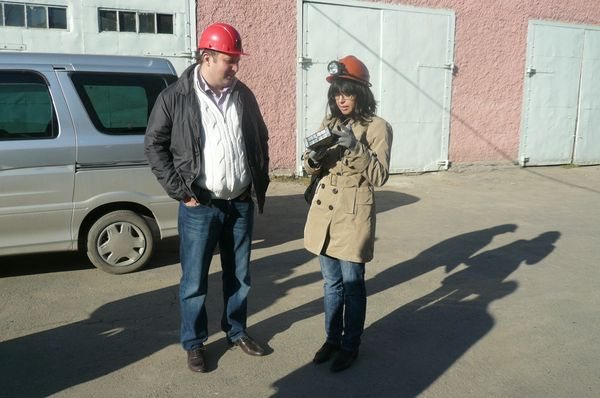
ATOR Executive Director Maya Lomidze and Head of the Domestic Tourism Department Ilya Umansky are ready to descend into the mine. It remains to study how the flashlight works.
The history of gold mining in Russia, old and modern methods of mining the precious metal, and the life of miners and prospectors is told in a private museum located in the training mine of the mine rescue unit. Valery Lobanov rented it, repaired it, placed mining tools there and “populated” it with the first miners - convicts of the Yekaterinburg prison. They greet tourists at the entrance and hide around every turn. One of them had his head half shaved, which means he was trying to escape.
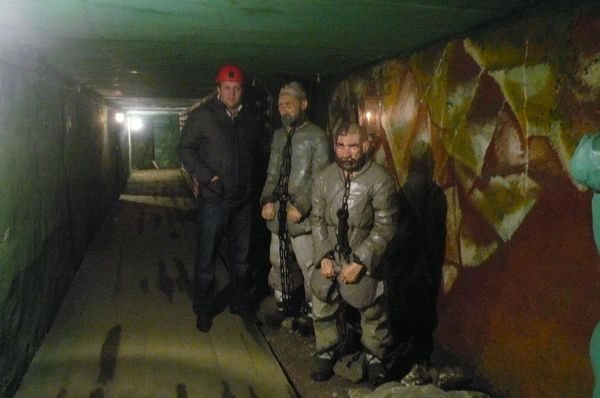
The other has a bell around his neck - this one has completely lost his trust. The training mine is no different from the real one, except that it is not deep. It has everything to create the most difficult conditions for mine rescuers: narrow manholes, a stove that heats a small room to 50 degrees, in which mine rescuers in full equipment must overcome half a thousand steps. Exercises are held regularly. Tourists have the opportunity to visit the real Severnaya mine, one of three currently operating. They are given a full set of protective clothing and are immersed to a depth of more than 500 meters, where a gold-bearing vein is currently being mined. We were not able to visit a real mine: applications must be submitted in advance.
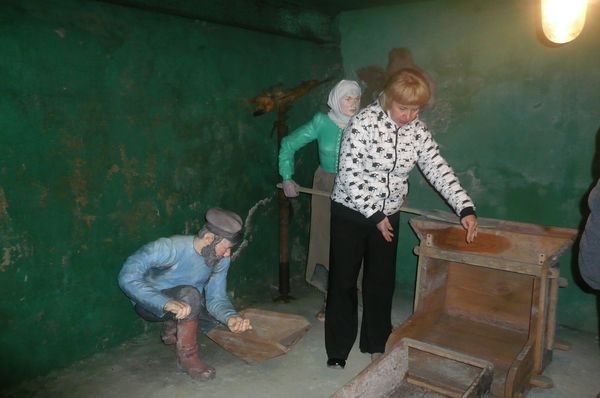
Until the beginning of the 20th century. gold-bearing ore was mined manually in mines at a depth of 5 to 50 m. The width and height of the tunnels was 2-3 m. The walls were reinforced with wooden beams. In all the Berezovsky mines there lives a white luminous mold, which in the pitch darkness looks very much like a ghost. There is such mold in the museum mine. The guide spoke with great regret about the loss of a large mold area in one of the rooms. He was a real decoration of the museum.
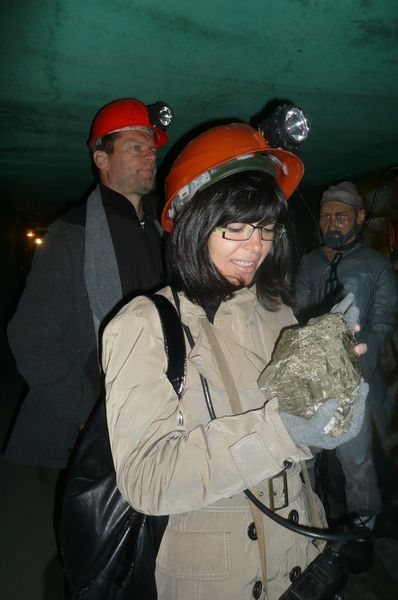
Pyrite is one of the gold-bearing ores at the Berezovskoye deposit. Maya Lomidze liked this museum exhibit - a huge pyrite crystal.
Rising from the mine, we saw schoolchildren waiting to go down into the mine. Thanks to the efforts of Valery Lobanov, excursions on “golden” themes have become very popular in the region.
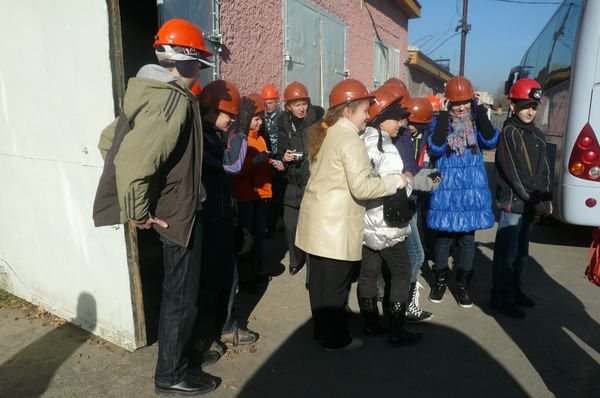
We were very lucky with the weather, so the excursion continued on the banks of the gold-bearing Berezovka River.
If only a few people know about Ural gold, then probably everyone has heard about Ural gems and ornamental stones. In addition to the well-known rocks - serpentine or jasper in Berezovsky in the 19th century. Berezite and listvenite were found for the first time. Back in the middle of the 19th century. The cutting industry was already thriving here. But the deposit’s worldwide fame was brought by a unique mineral found only here – crocoite. The mineralogical excursion for Aurum tourists is conducted not by guides, but by real geologists - practicing scientists working at the Berezovsky enterprises. We were accompanied by the senior engineer of one of the mines, Alexander Batalin. “Should you tell the story,” he asked, “scientifically or more simply?” We asked for something simpler. The story about “inanimate” nature turned out to be unusually lively and fascinating. Alexander Sergeevich explained in an accessible and simple way how minerals are formed and why they occur in one way and not another. With him to the river bank, he brought weighty books with maps and diagrams and photographs of unique minerals found at the Berezovskoye deposit. And the trunk of his car was full of not so valuable items. Small pebbles were intended for us as souvenirs.
Interactive programs allow you to feel like mineral explorers and prospectors. Alexander Sergeevich suggested that we look for underground treasures in the old proven way - with a frame. It turns out that it only reacts to the rock you are looking for. That is, if you focus on searching for gold, the frame will react specifically to it. We were told to focus on the quartz as we were standing on a quartz vein. And the frame rotated! Even in the hands of the incredibly skeptical Ilya Umansky.
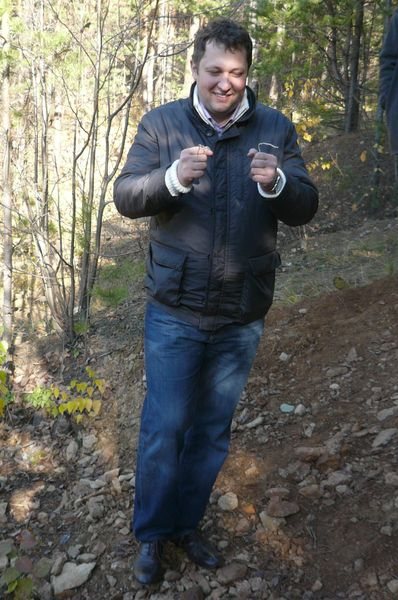
Well, so that we could make sure that the frame was not deceiving, we were handed a pick and offered to mine quartz crystals in the quartz vein that the frame “signaled” about. Despite the fact that the vein, apparently, had already been extensively explored by its predecessors, we managed to find several very nice crystals.
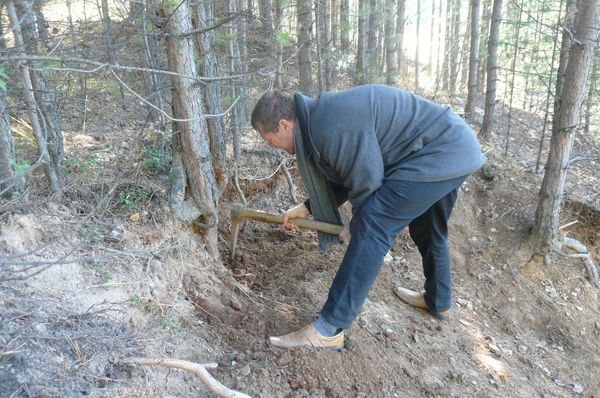
In 1814, another grand discovery took place in Berezovsky, which led to a revolution in the Russian gold mining industry. Ore master Lev Brusnitsyn discovered placer gold. It was incomparably easier to extract it than the “indigenous” one from gold-bearing veins. It was here that the real “gold rush” began in Berezovsky; rumors spread around the world that gold was being “raked with a shovel” here. With the discovery of gold placers, the mines at the Berezovsky mines practically stopped working, and the number of mines in ten years exceeded 2 thousand. But the Berezovsky prospectors, for the most part, did not get rich: they just as easily spent the money they received for easily mined gold and returned to the mines. In 1845, Russia came out on top in the world, producing half of the world's gold.

We, too, could not resist the temptation and for a whole hour, balancing on slippery stones in the Berezovka River, we washed the coastal sand. The interactive program “I would like to become a prospector” was also developed by Valery Lobanov. It turned out that you can wash gold with an ordinary plastic basin. However, it was possible to use one of the “active” exhibits from Batalin’s personal collection - an antique brass ladle. Alexander Sergeevich explained how not to miss precious grains when washing. The “gold rush” gripped us after the first “basin”. Having finished with one portion of sand, we immediately began the next one.
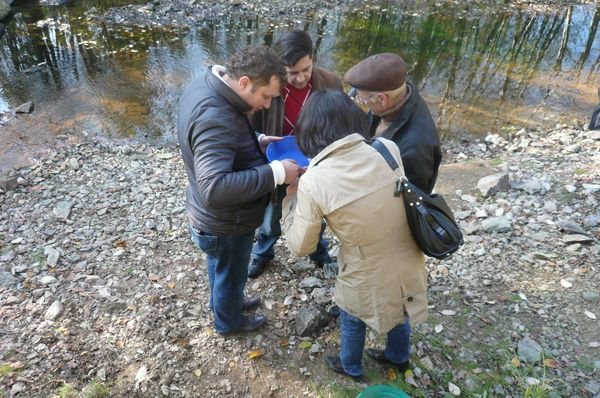
When a few grains remained at the bottom, everyone surrounded the “prospector”, hoping to see the coveted shine. We never found the precious metal, but we found small pieces of pyrite, a “companion” of gold. The found treasures were put into bags. Ilya Umansky turned out to be the luckiest. In his bag sparkled pieces of pyrite the size of a pinhead.
The tour ended at the Berezovsky cafe, where we had a wonderful lunch.
Miass gold - to the front
The high consciousness of the working people is evidenced by the example of the miners of the Lenin mine, who decided to contribute their daily earnings in gold terms to the defense fund on a monthly basis until the fascists were completely defeated.
The team of the Miasszoloto trust contributed 65 kilograms of precious non-ferrous metals.
For the construction of the Soviet Prospector tank column in 1941, the Miass residents contributed 9 kilograms 650 grams of gold and 4 million rubles in money.
Squadrons of aircraft “Gold-Platinum Industry” - 1 kilogram of gold and 1,570,000 rubles in money.
Miass residents collected 5,330 rubles in gold for the construction of the Chelyabinsk Komsomolets submarine.
The fund for creating a tank brigade named after the Chelyabinsk Komsomol received half a kilogram of gold and 400 thousand rubles in money.
The Miass residents also made a significant contribution to the construction of the Chelyabinsk Collective Farmer tank column: 4 kilograms of gold and 185 thousand rubles in money.
Squadrons of aircraft “Gold-Platinum Industry” - 1 kilogram of gold and 1,570,000 rubles in money
The Miasszoloto trust technically re-equipped mining operations, launched the shock movement and the Stakhanov movement, increasing the production of valuable metal. In the pre-war year, 1940, gold mining increased several times compared to the first year of the Five-Year Plan.
Development of the mine method
The development of the mine method of gold mining in the Southern Urals began to develop after the Second World War, when old mines began to be reconstructed and new ones were put into operation in the Kochkar gold mining region, as well as in other places in the Southern Urals. It seemed that in the coming years the mine mining method would completely replace the placer mining method. However, in 1942, the famous Soviet geologist V. A. Obruchev spoke quite clearly: “A whole series of experiments carried out at different times and at different mines of the Union revealed with full conviction that the waste from washing gold-bearing placers contains gold in quantities, often several times (our discharge - author) exceeds the amount obtained during washing and can be extracted. Not a single placer can be considered completely mined and, in general, the reserves of gold in placers are very large.” This statement fully applies to the Southern Urals. It all depends on the level of technical development and the development technology used.
Yuryuzan-News
In the Southern Urals there are quite a lot of legends associated with the Pugachev treasures. During the uprising of the 18th century, a lot of gold and other valuables fell into the hands of the Pugachevites. Hence the rumor and the tireless work of folk art. There are stories about Pugachev’s treasure on Chusovaya, on Yaik (Ural), on Tour and many other places. In the stories, the weight of the hidden gold only changes.
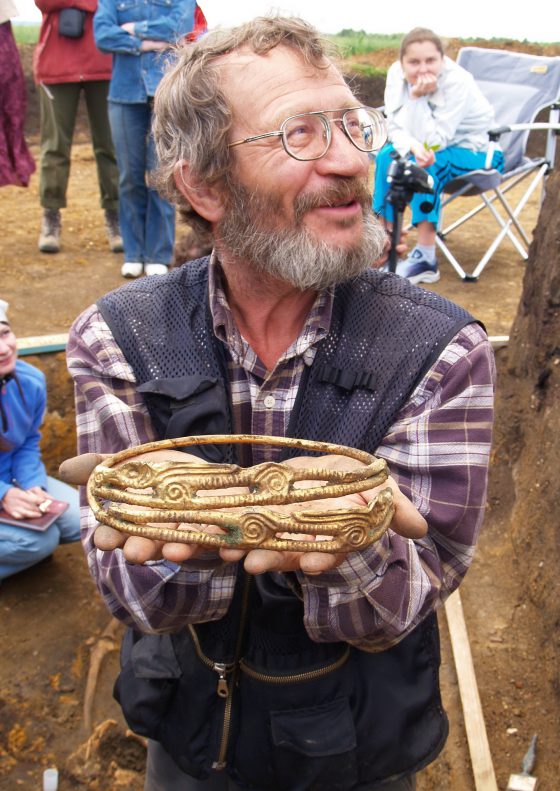
Quite recently, during one of his dives, a Chelyabinsk diver discovered a wooden boat at the bottom of Lake Uvildy. The ancient ship has been preserved almost in its original form and, as the searcher suggests, may be of historical value. According to archaeologists, the boat sank in the 19th century.
“Most likely, this is a ship from the early 19th century. It could be used by fishermen. But you can’t say for sure just from the video; you need to get the boat so that several specialists can evaluate it. Of course, this is a valuable ethnographic find, and the museum is ready to accept it as a gift. We already have a similar boat in the hall, raised from the bottom of Lake Ulagach.”
Alexey Shapiro, archaeologist of the Chelyabinsk Regional Museum of Local Lore
However, one of the options that treasure hunters are considering is different - this ship could have carried gold, topazes, and crystals. Due to the overload, the ship could not stand it and sank. The boat was raised in early June, but nothing was found.
Many legends of the Chelyabinsk region are dedicated to the burial places of treasures from the times of the Pugachev War in the Southern Urals. Many remain legends, and the authenticity of some is checked by local historians. Sometimes this happens: enthusiastic local historians rustle through the archives with brittle sheets of reports from the Ural factory departments of the 18th–19th centuries in search of indications of treasures, and find inventories of unknown outcrops of ore veins, quartz and other minerals.
It is known that Emelyan Pugachev did not take the entire treasury of the army with him. They hid it piece by piece in places that were marked with noticeable signs. There is a beautiful lake Turgoyak in the Southern Urals. Next to the huge lake, just 300 m away, there is another small lake, Istoe, muddy and completely opaque - Inyshka. In this small muddy lake, according to legend, Pugachev drowned a couple of barrels of gold. They began looking for this treasure immediately after its troops were defeated. They tried to get to the treasure through a tunnel from Lake Turgoyak, but they couldn’t. Then they tried to simply lift it from the bottom. Multi-meter deposits of sapropel and peat did not allow this to be done. Divers who descended to the bottom of the lake said that the entire gold reserve of Russia could be hidden there.
“I consider this legend not quite a legend. What is a legend? Fairy tale, fiction. And in our places the population attacked the search and extraction of the treasure with all the inherent diligence. But so far everything is to no avail. So the Pugachev treasure lies untouched and unmined.”
Vasily Rumyantsev, local resident
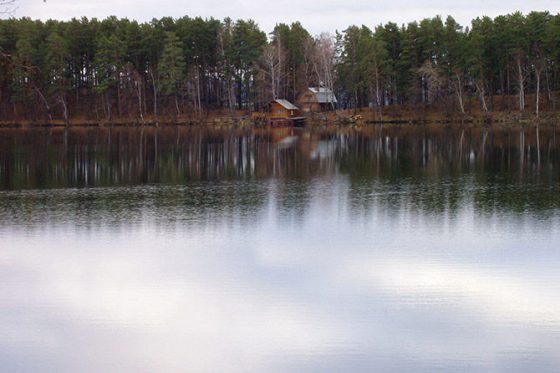
In almost every village in the Southern Urals, which did not escape the Pugachev unrest of 1773, old-timers tell legends about the treasures of Emelyan Pugachev. So, on the banks of the Ai River - the legend of three oaks. One of the Pugachev atamans, together with his wife, buried the stolen goods there. He was killed in battle, and Akulina’s wife lived to a ripe old age. She died in poverty, but told her loved ones about the location of the treasure.
Another place is the caves near the Bolshoye and Maloye Miassovo lakes. A certain grandfather from the village of Nepryakhino wanted to show his fellow villagers the place of Pugachev’s hidden treasures. Legend has it that even before the war, local men reached it. When they collected guns and all sorts of things, the cave collapsed. No one died, but the men were very scared and did not go there anymore.
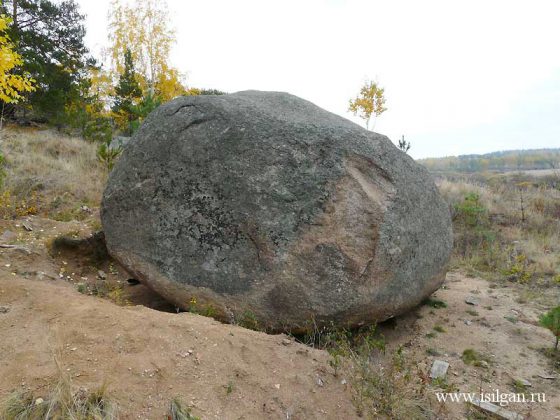
In the Troitsky district, near the former Cossack village of Stepnoe, there is a huge round block. It is not far from the Chelyabinsk-Magnitogorsk highway. Local residents are sure that it is under this block that the Pugachev treasure is buried. No matter what they tried to do with this stone—blow it up with a grenade, move it with a tractor, dig a tunnel—nothing was possible.

There are other riches too. So, they say that archaeologists were looking for an old Pugachev cannon, and found a ruined Demidov factory. Once a forester from the taiga cordon came to Chelyabinsk archaeologists and said that in the taiga on the border of the Nyazepetrovsky and Karabashsky regions, he saw the barrel of a cannon in a swamp. Most likely, Pugachevskaya. The forester promised to show the scientists the way, but did not come on the appointed day. On the phone number they left they answered that they had never heard of such a person. The archaeologists followed the pattern he left. Understanding the taiga roads was not easy, and archaeologists had to constantly stop and ask local residents for directions. One of them showed them the remains of the destroyed plant: the dam, workshops, water wheels. So scientists excavated the Azyash-Ufa plant, burned by Pugachev and then forgotten.
However, as it turned out, the treasures of the Southern Urals can be associated not only with Pugachev or the Demidovs. So, several years ago there was sensational news: archaeological scientists found an ancient Sarmatian burial in the Uvelsky region, near Kichigino. There were several mounds, and in one of them lay the remains of a priestess wearing gold jewelry. Her neck was adorned with a bronze hryvnia, covered with gold foil and decorated with figures of wild animals. There were gold bracelets and rings on their hands. All these decorations are now in the regional museum of local lore under glass, and not even copies, but originals. They were restored for about two years. Using the skull, they also reconstructed the face of a Sarmatian priestess, a woman of European appearance who was about 50 years old. Based on the results of the research, archaeologists suggested that the Kichiginsky burial ground was the burial place of representatives of a rather noble family, which was the owner of these places. Jewelry from these mounds is made of gold mined in the Southern Urals. This place is the Kochkarsky ore district, where gold is still mined. It is approximately 30–40 km from Kichigino.
“It is quite possible that this aristocratic family controlled gold mining in the area. In addition, the large number of bronze objects found in the burial site suggests that the wealthy Sarmatians controlled the supply of other metals from nearby regions. We found a burial that dates back to the 7th – early 6th century BC.”
Alexander Tairov, Chelyabinsk professor
They also look for treasures in old houses in Chelyabinsk. When restoring or reconstructing old mansions, there may be hidden or simply forgotten goods under the old floor or somewhere behind the plaster. For example, during archaeological excavations in the area of Kirov and Karl Marx streets, scientists found a knot in the ground, and in it bright green malachite. A couple of centuries ago, some master collected beautiful stones for crafts.
However, the Southern Urals have something to show besides Chelyabinsk. For example, the city of Plast is the local capital of gold miners. At the site of the old gold mines, local residents are still quietly looking for gold. They say that there is even an illegal purchase of gold dust in the city. And after the rain, local children walk through sandy workings and find precious and semi-precious stones - citrines, rock crystal and even topazes.
Troitsk is a former merchant city. There are many ancient churches and buildings, underground passages. The churches in Troitsk have underground passages where the priests hid church property. Today's church ministers deny the existence of such moves, so as not to provoke treasure hunters to plunder valuables. But local residents don't really believe them. In Kyshtym there was a residence of the Demidov breeders - a branch of one of the grandchildren of the founder of the famous family. True, already in the middle of the 19th century, the rich Demidovs began to live in St. Petersburg and abroad, and keep their money in reliable European banks. But so far it has not been possible to find the secret dungeon under the Demidovs’ estate, where, according to legend, there was a factory for the illegal minting of silver coins.
Based on materials from open sources on the Internet
Mid 20th century
By the middle of the 20th century, there were no more gold-bearing placers with a rich gold content in the rock mass left in the Miass Valley. They no longer even dreamed of a content of one gram per cubic meter of rock; they were satisfied with a content of 200-400 milligrams and even less. Gold miners had only one way to maintain the yield of gold - this was to increase the volume of processing of the rock mass. The industrial potential allowed the mine to switch to a hydromechanized method with an electric drive. Hydraulic mining methods are being improved - 8N3U dredgers are being introduced, and later, improved hydraulics 279 with a 3GM-2M dredger begin to work on the Kosoy Formation placer (Atlyan River).
Hydraulics is a method of extracting gold by eroding sand with a powerful stream of water. A liquid mixture of rock and water (called slurry) is directed into sluices and long wooden troughs with catchers, where the precious metal is collected. The introduction of hydromechanization sharply increased labor productivity in terms of rock mass, which made it possible to process old mining dumps and include placers that were not attractive to miners for processing. The results were: 1955 - 1 ton 13 kilograms of gold, approximately the same values in the next four years. There were many small and large nuggets. In 1957, 102 nuggets were found with a total weight of 13.6 kilograms. Here is an excerpt from a letter from K.Z. Abdrakhimov to the famous Ural local historian Yuri Kurochkin (August 1958): “...this August turned out to be truly golden for us! Only in the placer where hydraulics No. 305 operates, four large nuggets weighing more than five kilograms were found in a few days.
Natural resources
Miass is located in the northwestern part of the region, 72 kilometers west of the regional center. Located among the extreme eastern spurs of the Ural ridge in the valley of the Miass River. On the eastern side are the Ilmen Mountains, a unique natural complex. More than 260 species of minerals (almost a quarter of all known in the world) and rocks have been found in the Ilmensky Nature Reserve, there are 823 species of plants, 32 of which are listed in the Red Book. The fauna is widely represented: mammals -51 species, birds -165, fish -11.
“Blue Pearl of the Urals” - Lake Turgoyak. This is a reservoir of world significance, a natural monument of the Chelyabinsk region. The Kushtumga River is the only one in the Chelyabinsk region where trout is found. Between the Ural ridge and the Taganay spurs there is the Itsil ridge - a region of high-mountain nature with the remains of preserved primeval layers of forest stands.
The largest lakes are Bolshoye Miassovo, Bolshoi Elanchik, Ilmenskoye, Inyshko, Kysykul and others.
385 deposits and occurrences of minerals (196 primary, 189 placers) have been identified on the territory of the district, localized mainly in the valley of the Miass River, including ore gold, placer gold, talc, ornamental stones, chromium, building stone, copper, muscovite, nickel, iron, lead, molybdenum, niobium, titanium, aluminum, asbestos, graphite, fluxing limestone, ceramic raw materials, facing materials, clay, sand and gravel, peat, phosphorites, groundwater.
Currently being exploited: gold deposits, deposits of building materials: granite, marble, brick clay, sand, talc, fluxing limestone.
New nuggets
On August 15, hydraulics monitor Alexey Vasilievich Vakhonin picked up a nugget weighing 1387 grams, and less than an hour later, several tens of meters away, his partner Alexander Murzin found another one - 813 grams. The nugget weighing 1225 grams was lifted by the lock operator Sasha Usova, and three days later the shift monitor Ivan Ivanovich Meshkovsky overtook her. The nugget he found weighed 1658 grams. Three more days passed, and the head of hydraulics, Fyodor Mikhailovich Katerinich, was lucky - and he picked up a nugget weighing about a kilogram.
The nuggets are all interesting. They contain many voids of a pronounced cubic shape and inclusions of quartz - this is clear and irrefutable evidence that they were formed due to the destruction of primary deposits such as gold-quartz veins, mineralized mainly by pyrite. The small roundness of the nuggets indicates that they were transported close to their sources. The veins that gave birth to them are somewhere nearby...”
In August 1958, over fifty nuggets were found at that mine. August of that year was “golden” in the golden valley of Miass. We read further: “The people living nearby were once again seized by the excitement that had long died down. People went to old places, looked at the famous place “Pudovoye” in the center of Leninsk, where in the old days they picked up no less than a pound nugget. Some people did not disdain to dig again at the place “Vosmushka”, where, probably, they removed from the mother earth a nugget the size of an “octam”. But above “Pudovoy” itself, where the Lenin oil pumping station, again, after testing this place with hydraulics, they discovered amazing wealth! Every day, when changing shifts, workers turned off the hydraulics, went down into the quarry and picked up some precious piece - everything from 100 grams to a kilogram, or even up to three...!


